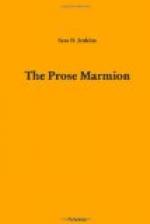“Day dawns upon the
mountain’s side:—
There, Scotland! lay
thy bravest pride,
Chiefs, knights, and
nobles, many a one:
The sad survivors all
are gone.
View not that corpse
mistrustfully,
Defaced and mangled-though
it be;
He saw the wreck his
rashness wrought;
Reckless of life, he
desperate fought,
And fell
on Flodden plain:
And well in death his
trusty brand,
Firm clench’d
within his kingly hand,
Beseem’d
the monarch slain.”
Little remains to be told. Fitz-Eustace, faithful to the last, bore “To Litchfield’s lofty pile,” what he believed to be the pierced and mangled body of his once proud master. Here was reared a Gothic tomb; carved tablets were set in fretted niche; around were hung his arms and armor, and the walls were blazoned with his deeds of valor; but Lord Marmion’s body lay not there. Midst the din and roar of battle, a poor dying peasant had dragged himself to the fountain where died the Lord of Fontenaye, the Lord of Tamworth tower and town. Spoilers stripped and mutilated both bodies and the lowly woodsman was carried to the proud baron’s tomb.
Through the long and dreadful fight, Wilton was in the foremost and thickest. When Surrey’s horse was slain, it was De Wilton’s horse on which the noble leader was again mounted. It was Wilton’s brand that hewed down the spearsmen. He was the living soul of all.
In that battle, he won back rank and lands, adding to his crest bearings bought on Flodden Field. King and kinsman blessed fair Clara’s constancy. As he reads, each must paint for himself the bridal scene, and imagine that,
“Bluff King Hal the
curtain drew,
And Catherine’s
hand the stocking threw;
And afterwards, for
many a day,
That it was held enough
to say,
In blessing to a wedded
pair,
‘Love they like Wilton
and like Clare.’”



